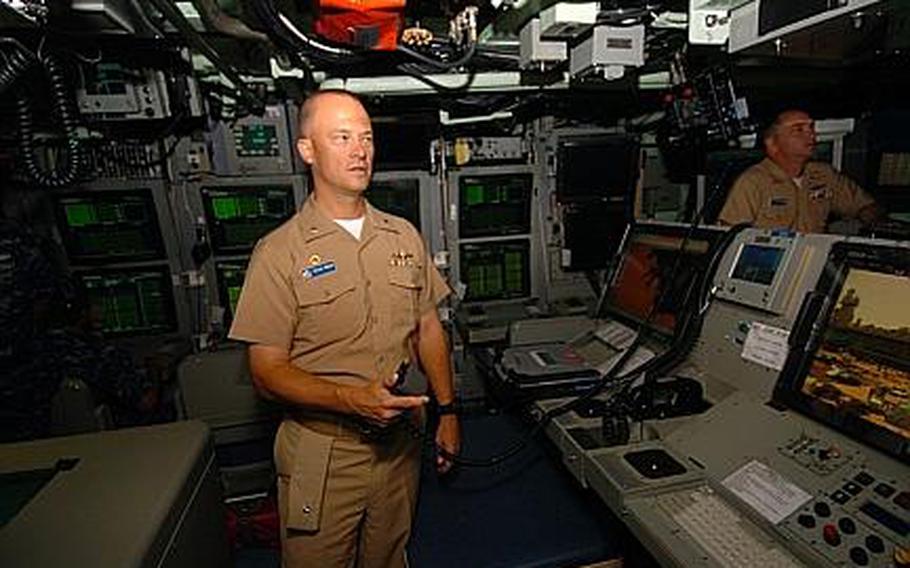
Instead of a periscope, USS Hawaii commanding officer Cmdr. Stephen Mack uses a controller to move a photonics mast that takes digital images of the ship's surroundings at Yokosuka Naval Base, Japan, on Tuesday. The images are then sent to a large-screen high-definition television. The visit by the Hawaii is the first by a Virginia class submarine to the 7th Fleet's Western Pacific-based area of operations. (Erik Slavin/Stars and Stripes)
YOKOSUKA NAVAL BASE, Japan — The USS Hawaii's arrival at Yokosuka on Friday marks the first port visit by a Virginia-class submarine in the Western Pacific.
The USS Hawaii’s arrival on Friday at Yokosuka for a port visit signaled the first time a Virginia-class submarine has entered the Western Pacific, Navy officials said Tuesday.
The relatively new fast-attack submarine’s arrival in Asian waters represents yet another piece of the Navy’s shift toward watercraft and weaponry designed to operate in nearshore waters.
However, while programs like the $25 billion Littoral Combat Ship series are running over-budget and behind schedule, the Navy’s underwater fleet is increasingly taking on responsibilities that find it coming up from the depths.
“It’s no longer about how fast or how deep a sub could go,” USS Hawaii commanding officer Cmdr. Stephen Mack said Tuesday. “It’s the ability to have a persistent presence off shallow areas.”
The Hawaii, which deployed in 2008 as the third of its class, can still dive beyond 800 feet and perform many of the same feats as its Cold War-era counterparts.
But while the much longer Ohio-class submarines carry far more missiles, subs like the Hawaii have technological edges well-suited for the often shallower waters found in parts of Asia with disputed boundaries, including the South China Sea and the waters off the Korea penninsula.
Submarine commanders tend to avoid talking about specific countries and operations, but they’re usually happy to talk about their boats. Mack was no exception aboard the Hawaii on Tuesday.
The Hawaii can not only drive itself, it can auto-hover and auto-stabilize, keeping the boat as quiet as possible while avoiding detection at varied depths, Mack said.
It also uses a sonar “chin array” to detect mines and other threats beneath the boat, an upgrade over the older Los Angeles-class subs that the Hawaii and boats like it are replacing.
“The Los Angeles-class is extremely capable, but it was designed in an era more focused on open ocean,” said Cmdr. Jeff Davis, spokesman for the 7th Fleet, which oversees the Western Pacific. The Hawaii and its class “add a lot of value, particularly in ... the littoral environments in which we operate.”
The new capabilities would aid the Hawaii if it ever operated in the often shallow waters near the Korean Northern Limit Line, where international investigators believe the South Korean ship Cheonan was destroyed by a North Korean torpedo in March.
The Hawaii also has an airlock chamber which it can use to launch Navy SEAL teams into nearshore waters.
Davis said the Hawaii was not scheduled to participate in a U.S.-South Korean anti-submarine exercise that was postponed this week due to a tropical storm off the peninsula.
He said there is no special reason why a Virginia-class sub hadn’t shown up in the Western Pacific sooner. However, with 12 Virginia-class subs expected to be ready by 2015, the boats will likely play an increasingly larger role in 7th Fleet plans.
“We are the first, but there are more to follow,” Mack said.